by Joanna | Going Green, Health
I’m inviting you to join me in the Food Revolution.
I participated in this event last year, and I learned soooo much, as well as got incredibly inspired by all the amazing people and the information.
(In fact I was so inspired, that I decided to use a similar slogan for my website: “Heal the body, heal the planet…beginning with food”. I also became an affiliate for the event.)
Bestselling author, John Robbins is sharing personal interviews of 23 people who are leaders in movements for healthy, sustainable, humane and delicious food. And you can join in — for free!
(If you don’t know who John Robbins (the host) is, you’ll be so inspired by his story. John Robbins could have inherited the Baskin-Robbins empire. But he walked away from the money and the power. Why? He simply didn’t want to devote his life to selling ice cream after realizing it makes people unhealthy. So he decided to make a change. Over the last 25 years, his books about healthy eating and healthy living (including bestsellers Diet for a New America and The Food Revolution) have sold millions of copies and been translated into more than 30 languages.)
Here is how it works. Every week, the Food Revolution Network hosts three interviews, and sends out a letter with a wealth of up-to-the-minute tools and resources. These tools can help you and your family to thrive and to make a difference in the world.
Get more info on the amazing speakers, and register here:
Food Revolution Network
You’ll get up-to-date information from an amazing array of visionary leaders and experts, including:
Expert doctors and acclaimed researchers such as Dean Ornish, MD (Preventive Medicine Research Institute) and T. Colin Cambell, Ph.D (The China Study);
Natural health pioneers such as Joseph Mercola (Mercola.com) and David Wolfe (Radiant Health Now) and Food system innovators such as Vandana Shiva (How to Stop Big Ag) and Ronnie Cummins (Organic Consumers Association), and many more inspiring visionaries.
NY Times best-selling authors Marianne Williamson (Spiritual Principles for Weight Loss) and Kathy Freston (Quantum Wellness);
Culture-changers and icons such as Morgan Spurlock (Supersize Me) and Rory Freedman (Skinny Bitch);
You’ll get the latest thinking on preventing and reversing heart disease, cancer and diabetes; the truth about GMOs, soy, raw foods, and grass-fed beef; the social, ethical and environmental impact of what you eat; and how to inspire your family to join you in making healthy choices.
All of this is FREE. Register Here
Happy Listening!
Joanna

by Joanna | Desserts, Featured, Going Green, Why Vegan
What do oatmeal chocolate chip cookies have in common with the Hurricane Sandy and global climate change? Let me explain.
I live in Northern New Jersey, in an area that has been affected by the recent hurricane Sandy.
I’m grateful that my family has not been greatly affected by this disaster, even though our area got a lot of flooding and trees had been broken.
Our storage compartment and our parking area got completely flooded, but we had moved our cars to safe locations prior to the storm, so the only things we lost is our AC unit that is located in the storage is not functioning, and our Christmas tree decorations getting completely soaked – so we had to discard them.
These are not devastating losses, I know, many people were not as lucky, losing their homes to water and fire.
As we recover from the disaster, I hear that now over 60% of people in the New York City area now believe in human-caused climate change, so the number of climate-change deniers is going down.
But does it mean we are taking the actions that are needed to reverse the damage that has been done and prevent any further damage?
Hardly.
As the Eastern coast recovers from Sandy, I listen to the Democracy Now! broadcasting from the annual U.N. Climate Change Summit, as it convenes in Doha, Qatar.
A shocking new report commissioned by the World Bank is warning temperatures could rise by 4 degrees Celsius (7.2 degrees Fahrenheit) by the end of the century, causing devastating food shortages, rising sea levels, cyclones and drought — even if countries meet their current pledges to reduce emissions.

If these promises are not met, the increase could happen even sooner. Meanwhile, scientists say it is still not too late to minimize the devastating impact of climate change. A separate report by the Climate Action Tracker says global warming could be kept below 2 degrees.
“This is an imminent risk that will affect every living person on the planet if we push the ecosystems of the world into a major extinction crisis, says Bill Hare, a leading physicist and environmental scientist who helped produce both of these latest reports.
I believe we should all get educated about what is happening in the world today. We all seem to be living in a bubble, not realizing what is going on around us, or – as Mary Robinson said in her interview for Democracy Now! “We’re all in a kind of sinking ship together, going into a 4-degree-or-plus world. ”
Well, climate change is very real and it is an imminent risk that will affect all of us – every living being on the planet. It will push the ecosystems of the world into a major extinction crisis. It will cause massive problems for us humans.
Listen to the full interview here. You can also download it to your iPod or mp3 player and listen whenever you can. I also listen to it at Pacifica WBAI.

So we need to get educated, but education is just the first step. The second is start taking action. We all need to become activists in the modern world.
And, even though, there is no easy way out of this horrific situation, and it’s easy to feel powerless and overwhelmed, there are certain easy-to-implement things that each and everyone of us can do – beginning today – but more about this later.
Post Hurricane Sandy
As I took a walk around my neighborhood with my son Adam assessing the damage (I live in a condominium complex) – he was happy and running around excited (no school for the whole week!) – I couldn’t help but wonder what will the world be like for him in 20, 40, or 60 years.
What will the future bring?
What kind of world will it be when we have far more weather shocks, far more drought, far more food insecurity and water stress?

After Sandy – Taking a walk with my son around our neighborhood

After Sandy – despite the disasters – the moods are high
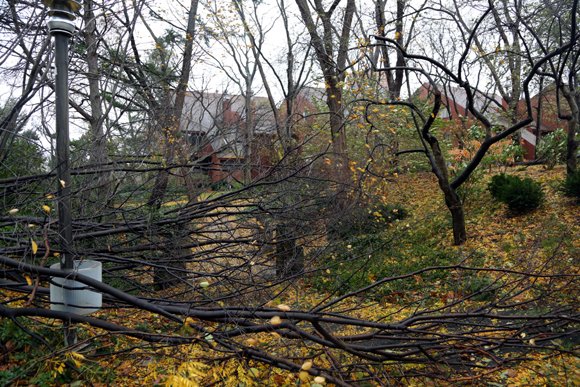
After Sandy – Fallen trees and broken branches
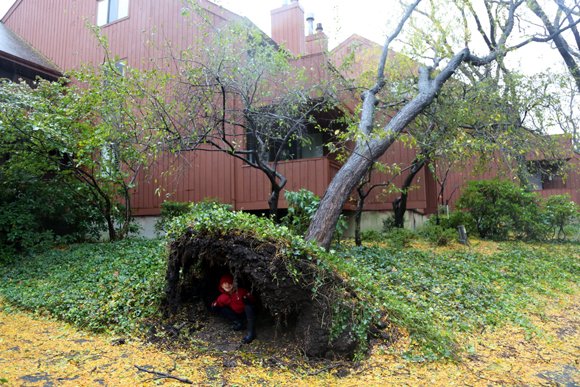
My son hiding under a fallen tree

After Sandy – Taking a walk in my neighborhood – flooded deck

After Sandy – flooded parking lots and destroyed marina (in the back)
In the Wake Of Hurricane Sandy
It easy to feel frightened and powerless in the face of such disaster.
But what can an individual do?
Do individual actions even matter?
Will individual actions be enough?
Of course, an individual cannot reverse the damage that has already happened. Individually, we can only do so much.
But, does it mean we should just give up?
There is still a lot each of us can do – without impacting our lives too dramatically or causing too much hardship.
“Don’t do nothing because you can’t do everything. Do something. Anything.” says Colleen Patrick Goudreau on one of my favorite podcasts “Food For Thought” at CompassionateCooks.com
One thing we can do easily do is to change our diet.
So my action for the day following Sandy – after taking a stroll around my neighborhood – was to make vegan oatmeal chocolate cookies.
Why make vegan cookies? I wrote about the benefits of switching to vegan diet here. People do it for health or ethical reasons.
But you can also do it for the environment.
Did you know that our entire food production system – from growing crops and raising livestock, through distribution, and waste removal – is responsible for approximately one-third of all man-made greenhouse gas emissions?
While most people are well aware that meat and dairy consumption are associated with heart disease, cancer and diabetes; few of us realize that raising animals for food is one of the top contributors to the worst environmental problems around the planet at every level – from local to global.
Here are a few more facts for you it’s worth to know about:
– Livestock production alone is responsible for as much as 18 percent of the global climate change.
– Animal agriculture is a greater contributor to global warming than transportation, according to the United Nations. And due to their high methane output, cattle are one of the worst offenders of all farmed animals.
– The livestock sector is responsible for 18 percent of greenhouse gas emissions, about 40 percent more than the entire transport sector – cars, trucks, planes, trains and ships – combined (according to the UN).
– Nearly 10.2 billion land animals were raised and killed for food in the US in 2010. Globally, the number of land animals killed each year for food has exceeded 65 billion. Approximately 53 billion aquatic animals were killed for food in the U.S. in 2010.
– Animal agriculture uses enormous quantities of water, monopolizes land that could be more productive for crops, and contributes to deforestation of critical rainforest and other habitats.
– It takes over 5,000 gallons of water to produce one pound of meat.
– 55% of our fresh water is being given to livestock.
– Over 70 percent of the grain in the US is fed to livestock.
– 70% of rainforests have been slashed and burned in order to raise livestock.
– One acre of land, if used for vegetables, grain, and/or legumes, yields 10-20 times the amount of food in pounds than if devoted to meat production.
– Omnivores contribute seven times the volume of greenhouse gases that vegans do.
Oatmeal Chocolate Chip Cookies Recipe For the Changing World
So here is a vegan oatmeal chocolate cookies recipe for you.
I’m making the cookies dairy and egg-free. Making egg free and dairy-free cookies is actually very easy and fast once you learn about some good egg substitutes for baking and cooking (check out this easy pancake recipe too!).
Oatmeal Chocolate Chip Cookies
Ingredients
- 2 cups quick-cooking oats
- 2 cups all purpose flour
- 2/3 cup vegetable oil
- ¾ cup brown sugar, packed
- ¼ cup white sugar
- 1 teaspoon vanilla extract
- 1/2 teaspoon salt
- 1 teaspoon baking soda
- 1/2 teaspoon baking powder
- 1/2 cup nondairy milk
- 1 tablespoon ground flax seeds
- 1 cup chopped pecan pieces
- ½ cup vegan chocolate chips (or more 🙂
- ½ cup shredded coconut
- Additional nuts and chocolate chips for decorating tops of cookies (optional)
Instructions
- Preheat oven to 350F. Line tow baking sheets with parchment paper.
- In a medium size bowl mix oats, flour, baking soda, baking powder and salt. Set aside.
- In a large bowl, beat together oil, nondairy milk, sugar, flax seeds, and vanilla. Fold in the flour mixture, and add chocolate chunks, and pecans. Don't overmix. The dough will be thick and sticky.
- For each cookie, drop 1/4 cup dough onto cookie sheets. Flatten slightly. Bake at 350F for 15 to 20 minutes, until edges begin to brown. Let the cookies rest for 5 minutes. Enjoy!
- Yield: 2 to 3 dozen.
3.1
https://greenreset.com/making-oatmeal-chocolate-chip-cookies/
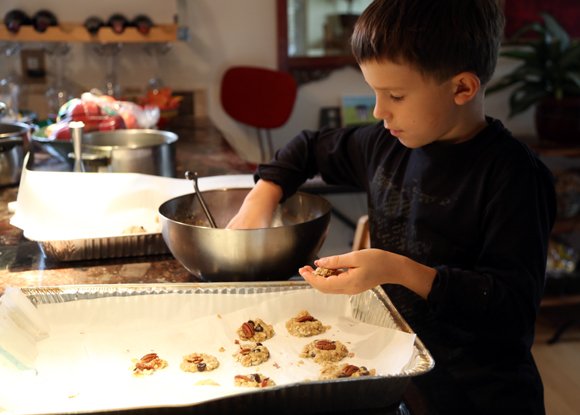
As I’m making cookies with my son, I find it hard not to think about what will future bring for him in the next 20, 40, 60 years…
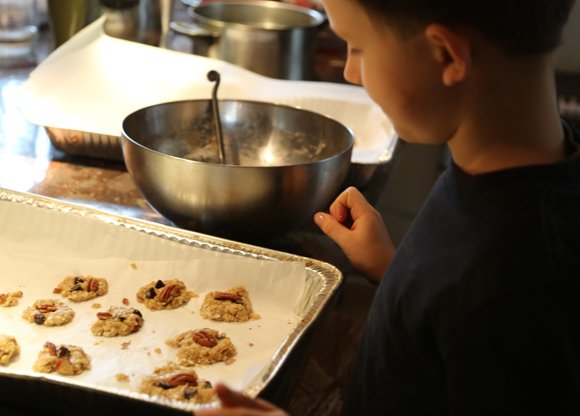
Making faces – mostly happy, smiling, but some sad and angry, too.

Tasting Oatmeal Chocolate Chip Cookies (my son, Adam)

Oatmeal Chocolate Chip Cookies

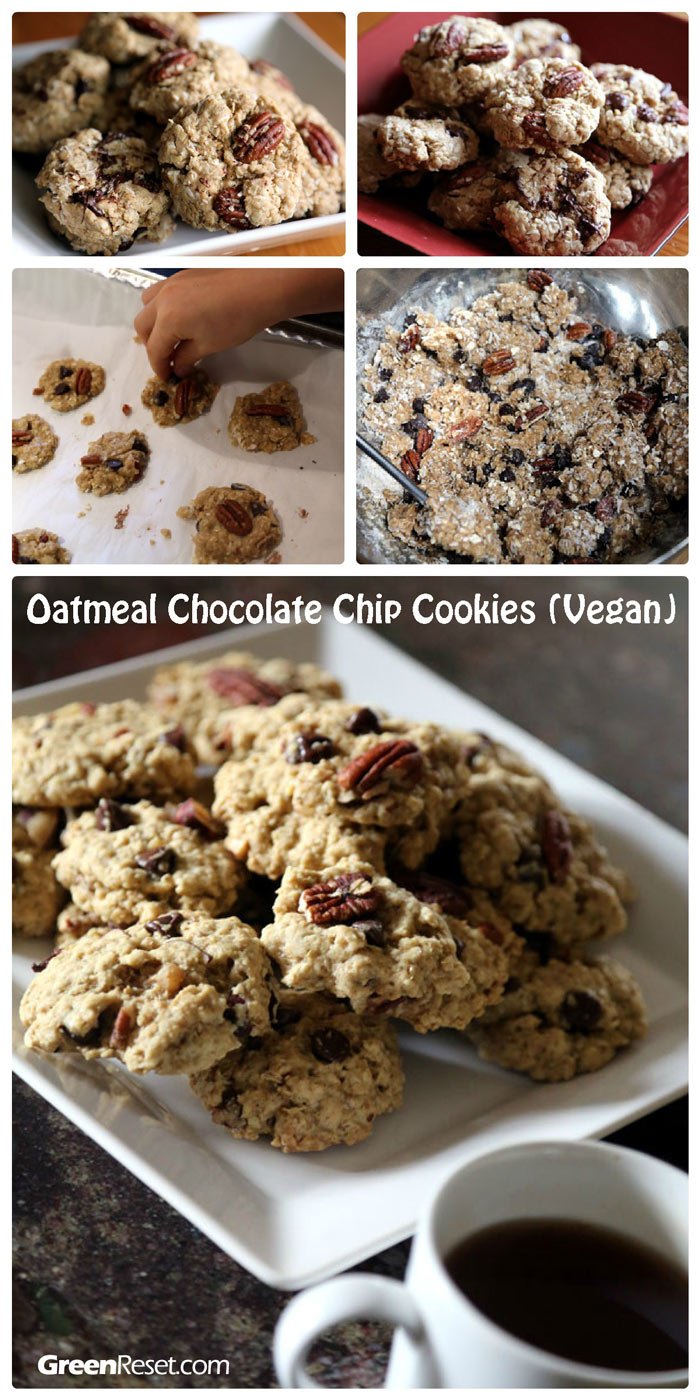
Questions? Comments? Suggestions?
If you have a favorite recipe, why not submit it here in the comment section of this blog for others to enjoy too!
I also welcome any comments, questions and suggestions. Thanks!
by Joanna | Going Green, Why Vegan
Do you love shrimp? If you do, you are certainly not alone.
I used to love eating them too.
Until I learned about the environmental impact of catching and farming shrimp.
Truth is the impact of bringing shrimp to our tables to satisfy our taste can be horrific.
But most Americans don’t know where their shrimp comes from or what’s in it.
Read this, and your appetite for shrimp (and other seafood) will dwindle.
“Americans love their shrimp. It’s the most popular seafood in the country, but unfortunately much of the shrimp we eat are a cocktail of chemicals, harvested at the expense of one of the world’s productive ecosystems. Worse, guidelines for finding some kind of “sustainable shrimp” are so far nonexistent.
In his book, Bottomfeeder: How to Eat Ethically in a World of Vanishing Seafood, Taras Grescoe paints a repulsive picture of how shrimp are farmed in one region of India. The shrimp pond preparation begins with urea, superphosphate, and diesel, then progresses to the use of piscicides (fish-killing chemicals like chlorine and rotenone), pesticides and antibiotics (including some that are banned in the U.S.), and ends by treating the shrimp with sodium tripolyphosphate (a suspected neurotoxicant), Borax, and occasionally caustic soda.
Upon arrival in the U.S., few if any, are inspected by the FDA, and when researchers have examined imported ready-to-eat shrimp, they found 162 separate species of bacteria with resistance to 10 different antibiotics. And yet, as of 2008, Americans are eating 4.1 pounds of shrimp apiece each year — significantly more than the 2.8 pounds per year we each ate of the second most popular seafood, canned tuna. But what are we actually eating without knowing it? And is it worth the price — both to our health and the environment?
Understanding the shrimp that supplies our nation’s voracious appetite is quite complex. Overall, the shrimp industry represents a dismantling of the marine ecosystem, piece by piece. Farming methods range from those described above to some that are more benign.
Problems with irresponsible methods of farming don’t end at the “yuck,” factor as shrimp farming is credited with destroying 38 percent of the world’s mangroves, some of the most diverse and productive ecosystems on earth. Some compare shrimp farming methods that demolish mangroves to slash-and-burn agriculture. A shrimp farmer will clear a section of mangroves and close it off to ensure that the shrimp cannot escape. Then the farmer relies on the tides to refresh the water, carrying shrimp excrement and disease out to sea. In this scenario, the entire mangrove ecosystem is destroyed and turned into a small dead zone for short-term gain. Even after the shrimp farm leaves, the mangroves do not come back.
A more responsible farming system involves closed, inland ponds that use their wastewater for agricultural irrigation instead of allowing it to pollute oceans or other waterways. According to the Monterey Bay Aquarium’s Seafood Watch program, when a farm has good disease management protocols, it does not need to use so many antibiotics or other chemicals.
One more consideration, even in these cleaner systems, is the wild fish used to feed farmed shrimp. An estimated average of 1.4 pounds of wild fish are used to produce every pound of farmed shrimp. Sometimes the wild fish used is bycatch — fish that would be dumped into the ocean to rot if they weren’t fed to shrimp — but other times farmed shrimp dine on species like anchovies, herring, sardines and menhaden. These fish are important foods for seabirds, big commercial fish and whales, so removing them from the ecosystem to feed farmed shrimp is problematic.
Additionally, some shrimp are wild-caught, and while they aren’t raised in a chemical cocktail, the vast majority is caught using trawling, a highly destructive fishing method. Football field-sized nets are dragged along the ocean floor, scooping up and killing several pounds of marine life for every pound of shrimp they catch and demolishing the ocean floor ecosystem as they go. Where they don’t clear-cut coral reefs or other rich ocean floor habitats, they drag their nets through the mud, leaving plumes of sediment so large they are visible from outer space.
After trawling destroys an ocean floor, the ecosystem often cannot recover for decades, if not centuries or millennia. This is particularly significant because 98 percent of ocean life lives on or around the seabed. Depending on the fishery, the amount of bycatch (the term used for unwanted species scooped up and killed by trawlers) ranges from five to 20 pounds per pound of shrimp. These include sharks, rays, starfish, juvenile red snapper, sea turtles and more. While shrimp trawl fisheries only represent 2 percent of the global fish catch, they are responsible for over one-third of the world’s bycatch.
Trawling is comparable to bulldozing an entire section of rainforest in order to catch one species of bird.”
Via Alternet by Jill Richardson
The article fails to mention shrimp produced in the New Orleans Delta. In addition to the recent oil spill, the whole area is an ecological disaster due to the dead zone. The dead zone is caused primarily by herbicide & fertilizer run off from the Mississippi watershed.
Here is what one fisherman says about fishing in the delta:
“Years ago, to raise money for repairs to my sailboat, I took a job as a deck hand on a shrimp trawler, a North Carolina boat operating out of Key West. Along with about 50 other boats based there, we trawled in the Gulf of Mexico for roughly two week trip periods and two of those trips were all I could stand in realizing the incredible environmental damage being done.
The ratio of what’s euphemistically called “trash” to shrimp when dumped on deck, representing the full spectrum of other marine life, is more like 50 lbs. to 1. Heavy chains weigh the nets to the bottom and drag clearing everything but heavy obstructions. A large following of sharks accompany every trawler lured by a seeping wake of fish oil and feed voraciously when the catch is culled by hand and the “trash” pushed overboard. (One does not want to lose one’s footing on a pitching deck.) This process continues repeatedly all night, every night.
I could go on about how many other environmental abuses occur in this one fishery. Like the hate for sea turtles that foul nets which are frequently killed when extracted if they’re not drowned by the trawl itself, and the bored captains that shoot anything that moves for sport with the automatic armory that each vessel carries in defense of piracy threats, and the violations of trawling through designated fish nurseries, and the dumping of chemicals used in boat maintenance, and more.
It’s a nasty, exploitative, destructive stomach turning process like so many other short sighted, greed driven and poorly regulated industries. Pound of destruction for pound of product it’s about as bad as it gets.”
At one point in the article Jill Richardson asks the question:
“Given this disturbing picture, how can an American know how to find responsibly farmed or fished shrimp?” and responds “Currently, it’s near impossible.”
I disagree.
Just don’t eat shrimp. It’s really that simple.
Read My New Ebook: Truth About Eating Fish and Fish Oil
You may be rolling your eyes at another “truth” being exposed, but I challenge you to read my new ebook and tell me you did not learn something new.

Read the entire book: The Truth About Eating Fish and Fish Oil
Coming soon to Amazon Kindle!
Questions? Comments? Suggestions?
If you have a favorite recipe, why not submit it here in the comment section of this smoothie recipes blog for others to enjoy too!
I also welcome any comments, questions and suggestions. Thanks!
by Joanna | Going Green, Why Vegan
The octopus is an intriguing creature of the seas that derives its name from a Greek word which means eight-footed.
They are found in various parts of the oceans, most commonly in the coral reefs. Octopuses, some 300 species of which inhabit tropical waters around the world, can change colors, squirt out poison, and exert a force greater than their own body weight.
We like to believe that we’re the smartest creatures on the planet. But the more we understand octopuses, the more it seems that we may not be alone in our ability to solve problems, make complex connections between ideas, and survive by wits alone.
Scientists have found that octopuses can navigate their way through mazes, solve problems quickly and remember those solutions, at least for the short term. A growing body of evidence suggests that octopuses show elements of human-like intelligence. But their intelligence has evolved for very different reasons than ours did, which makes them particularly difficult to understand.
Octopuses are preyed upon by sharks, dolphins, morays and conger eels.
But by far the biggest threat to octopuses (as well as other sea creatures) are humans.
All octopus species are suffering from overfishing, with no fishery management and dwindling numbers. They are also caught in large numbers as bykill with long line and other fishing methods.
Bizarre Foods Featuring Octopus
In case you don’t know, Bizarre Foods with Andrew Zimmern is a documentary-styled travel and cuisine television show hosted by Andrew Zimmern on the Travel Channel.
I don’t watch the show, but it does present some truly bizarre food choices “Bizarre Foods focuses on regional cuisine from around the world which is typically perceived by Americans as being disgusting, exotic, or bizarre.
In each episode, Zimmern focuses on the cuisine of a particular country or region. He typically shows how the food is procured, where it is served, and, usually without hesitation, eats it. You can find a whole list of the episodes and foods on wikipedia.
While the chef is enjoying celebrity status and a highly-coveted spot on prime-time television, here is a point of view that describes it for what his show really is: mindless, heartless entertainment “essentially sensationalizing the gruesome, medieval act of torturing, slaughtering, and eating creatures that, if they had a choice, would certainly run, fly, or swim in the other direction—away from this predator.”
Here is the excerpt from the Comfortably Unaware blog:
Andrew begins by walking into a crowded, noisy restaurant in Japan sitting down between two people on a stool at a counter—behind which, the cooking is accomplished for all to see. Zimmern states that this is why he “loves restaurants in Japan” because of “their noise and also freshness of seafood.” The camera then, on cue from the “freshness” comment, turns to capture the chef pulling an octopus out of a pan on the floor.
The octopus was, of course, very “fresh” and very alive as it gracefully and purposefully moved the tips of its eight legs, gently up and down the chef’s hands and arms as the animal tried to assimilate textures, colors, and temperatures, attempting to make sense out of its new surroundings. That’s what octopuses (or octopi) do.
They are quite intelligent beings with a large cognitive brain and complex sensory input mechanisms that researchers have recently found to be able to problem solve. They can gather information, process it, and then implement well thought out functions. Female octopuses are very sensitive with a strong maternal instinct—so strong that they mandatorily give up their life in the process of having offspring and protecting them after birth.
The Bizarre Foods’ camera crew then moved back to Zimmern. The person sitting in the next stool put her hand on his baldhead and said “the octopus has a head like yours”, referring to Zimmern’s shiny, hairless scalp. A good laugh ensued while the camera focused on the chef pushing the octopus down with both his hands into a pot of boiling oil over a red-hot burner in order to kill and cook the poor unsuspecting octopus.
We weren’t allowed to see how the octopus reacted to being held in oil as it was being boiled to death—portions to be then later served for Zimmern to eat. Imagine, for just a moment, what that octopus must have experienced as it went from attempting to carefully feel, see, interpret, and adapt to the chef’s hands with the thousands of sensory receptors on its legs—sending those inputs to an intelligent and quickly processing brain—to the next moment of being forcefully held in boiling oil, scalded to death. Actually, you can’t really imagine it, because you are not an octopus.
Although we are still learning about octopuses, (while killing 2.5 million tons of them and other cephalopods such as squid each year) it is has been quite well established that they are very sentient beings that feel and think in ways we do not understand. It can also be said that like all animals, octopuses only eat what they need to in order to survive. They kill only because they NEED to and without knowing that they are inflicting pain or suffering on any other living thing—quite unlike Andrew Zimmern and 98% of all other humans on this planet who kill because they WANT to kill, and then eat whatever it was that they just killed. All this, for no nutritional reason (there are many plant based foods that are infinitely healthier for us to consume). So, no, the person sitting next to Zimmern was not correct with her comment to him. The octopus does NOT have a “head” like his.
Bizarre Foods, Andrew Zimmern, and the Head of an Octopus
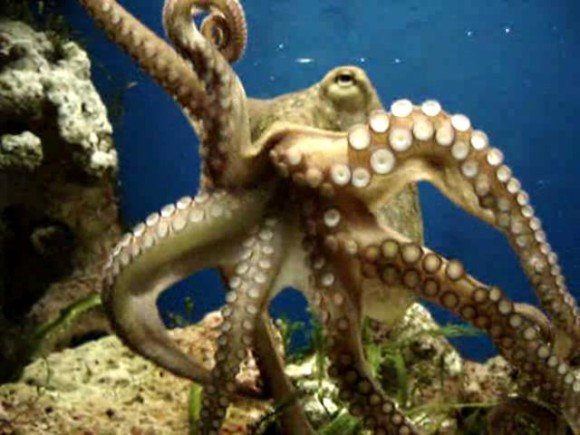
Questions? Comments? Suggestions?
If you have a favorite recipe, why not submit it here in the comment section of this smoothie recipes blog for others to enjoy too!
I also welcome any comments, questions and suggestions. Thanks!
by Joanna | Going Green, Why Vegan
This is an issue I’ve been struggling for many years now time now. I’ve been trying to switch to 100% plant-based diet, but I have to admit it’s been difficult. It’s hard to change if you’ve been eating this way for over 40 years, with my entire family against it, considering me crazy and irresponsible (as a mother) for even trying to give up meat, so it’s been a struggle.
I did manage to significantly reduce how much meat we all eat – which makes me somewhat happy – but I’m making a new commitment to limit it even further, and to become 100% vegan myself.
Here is why.
4 Compelling Reasons To Switch To Vegan Diet
1. Plant Eating for Health
Let’s start with what concerns us most – our own healthy body.
There seems to be a lot controversy surrounding the issue of whether or not animal foods are good for humans. Those who are in favor argue that meat and dairy have been an important part of the human diet for thousands (if not millions) of years. While it’s certainly true, many scientists argue that our anatomy, physiology, biochemistry, and psychology all indicate that we are not carnivores.
A simple test about our true nature would be to put a child in a room with a lamb and a banana. Note which one he plays with and which one he eats.
“To say that carnivores eat meat does not accurately portray such creatures. Animals that live on other animals usually eat raw meat, straight from the carcass, devouring the muscle meat, organs, and sucking up the warm, fresh blood and other bodily fluids. They even crush, split and eat the smaller bones and their marrow. Most people don’t salivate at the idea of crushing the life out of a rabbit with our bare hands and teeth, and the thought of eating one in a freshly killed state is repulsive. The vast majority of people agree that if they had to kill the animals in order to eat, they would not eat meat ever again.” (from 80/10/10 by Douglas Graham).
Today, animal foods have a central place in the Western-style diet. Meat and dairy have grown into big industries, so there are also many interests at stake here – big corporations fighting for huge profits. These industries have successfully lobbied and influenced the government, resulting in favorable laws and subsidies – and resulting in advertising and marketing propaganda being fed to the general public of all ages, starting with children. They have been selling us the mistaken idea that we need meat dairy and eggs in order to be properly nourished.
Many of us have been raised believing that “we need our protein” and “we need calcium for strong bones”, as if that protein and calcium could only be obtained from one source: animal products. We even often use “meat” and “protein” interchangeably, as if they are one and the same, which of course, they aren’t.
Protein is a type of nutrient that can be obtained from various sources, not just animal products, but most (if not all) plant foods contain protein too. Some plant foods, such as greens or beans, contain a lot of protein that is easily available and healthy for humans.
There is lots of research out there that proves beyond a doubt that plant based diet is what humans were originally *designed* by nature to eat, and that these foods are actually best for our health.
Many scientific studies confirm that the plant based diet helps prevent many types of cancer, cardiovascular diseases, diabetes, and other degenerative diseases, as well as slows down aging.
In addition to causing heart disease and cancer, animal products contain harmful contaminants—including bacteria, arsenic, dioxins, and mercury—that can affect our health both in the short and long terms.
Here is an excerpt from an interview with Dr. Esselstyn, one of the world’s leaders in heart attack prevention, where he gives some interesting examples illustrating this issue:
“It is quite striking that even today if you are a cardiac surgeon and you are going to hang out your shingle either in rural China, New Guinea, Central Africa or the Tarahumara Indians in Northern Mexico, just forget it. You better plan on selling pencils because you are not going to have any cardiovascular disease because there is none. These cultures by heritage and tradition are fully plant based.
Yet by way of contrast when we look at the autopsies of our twenty year old GIs in Korea and Vietnam, fully 80% already had gross evidence of coronary disease that you can see without a microscope, though not enough to have their cardiac event yet. That study was repeated about forty years later in 1999. This time it was done in this country looking at young women and men between the ages of 17 and 34 who had died of accidents, homicides and suicides. Now the disease is ubiquitous. Everybody at that young age already had the foundation of coronary disease. So it is very discouraging to think that when you graduate from high school in this country, not only do you get a diploma but you also get a foundation of coronary disease.
We really have been doing some things wrong.
I think this is further accentuated from a very interesting phenomenon that occurred during World War II when the access powers of Germany overran the low countries of Holland and Belgium and they occupied Denmark and Norway. It was characteristic that the Germans would take away the livestock from these cultures, namely their cattle, their sheep, their goats, their pigs, their turkeys gone.
So now suddenly these Western European nations during the war years were deprived of animal food and dairy. It was quite striking to see the report in The Lancet, England’s premier medical journal, in 1951 by Dr.’s Strom and Jansen who reviewed the Norwegian experience with heart attack and strokes during those war years. It was quite striking from 1939 to 1945 deaths from stroke and heart attack in Norway absolutely plummeted, just plummeted.
As soon as there was a cessation of hostilities immediately back came the meat, back came the dairy, back came the heart attacks and back came the stroke.”
Although even most mainstream experts agree that most Americans would benefit from eating a more plant-based diet, meat and dairy producers successfully block any effective campaigns aimed at reducing the amount of animal products consumed, including actively interfering with the USDA Pyramid, and now “My Plate” recommendations for the American public, or suing public figures who dare to suggest people to eat less meat (Oprah comes to mind).
2. Plant Eating to Lower Your Environmental Footprint
Many people don’t concern themselves much about the climate change and the environmental destruction that is happening before our very eyes. We don’t really think about it on a day-to-day basis and there is precious little information about these issues in the mainstream media.
However, let me ask you this question:
Why concern yourself with staying healthy, brushing our teeth, exercising, and other trivial tasks, if we destroy the only planet we know that is inhabitable for humans?
Or, why do we even worry about our children not drinking sodas and saving them from obesity, diabetes, and a host of other diseases – if we keep destroying this planet? Where will they go – is there a plan B?
Did you know that our entire food production system – from growing crops and raising livestock, through distribution, and waste removal – is responsible for approximately one-third of all man-made greenhouse gas emissions?
While most people are well aware that meat and dairy consumption are associated with heart disease, cancer and diabetes; few of us realize that raising animals for food is one of the top contributors to the worst environmental problems around the planet at every level – from local to global.
Here are a few more facts for you it’s worth to know about:
– Livestock production alone is responsible for as much as 18 percent of the global climate change.
– Animal agriculture is a greater contributor to global warming than transportation, according to the United Nations. And due to their high methane output, cattle are one of the worst offenders of all farmed animals.
– The livestock sector is responsible for 18 percent of greenhouse gas emissions, about 40 percent more than the entire transport sector – cars, trucks, planes, trains and ships – combined (according to the UN).
– Nearly 10.2 billion land animals were raised and killed for food in the US in 2010. Globally, the number of land animals killed each year for food has exceeded 65 billion. Approximately 53 billion aquatic animals were killed for food in the U.S. in 2010.
– Animal agriculture uses enormous quantities of water, monopolizes land that could be more productive for crops, and contributes to deforestation of critical rainforest and other habitats.
– It takes over 5,000 gallons of water to produce one pound of meat.
– 55% of our fresh water is being given to livestock.
– Over 70 percent of the grain in the US is fed to livestock.
– 70% of rainforests have been slashed and burned in order to raise livestock.
– One acre of land, if used for vegetables, grain, and/or legumes, yields 10-20 times the amount of food in pounds than if devoted to meat production.
– Omnivores contribute seven times the volume of greenhouse gases that vegans do.
The UN summarized the environmental effects of the meat industry this way: raising animals for food (whether on factory or traditional farms) “is one of the top two or three most significant contributors to the most serious environmental problems, at every scale from local to global. [Animal agriculture] should be a major policy focus when dealing with problems of land degradation, climate change and air pollution, water shortage and water pollution and loss of biodiversity. Livestock’s contribution to environmental problems is on a massive scale. ”
3. Plant Eating for Ethical Treatment of Animals
Animals suffer much more today than they did in the past. Up until the invention of modern farming, chickens would wander around the village, cows grazed the fields. The introduction of the factory farm changed all this. Today, the life of most meat animals is unimaginable suffering.
Welcome to Concentrated Animal Feeding Operations (CAFOs). CAFOs are animal feeding facilities that confine animals for more than 45 days in an area that does not produce vegetation during the growing season. In a CAFO, animals are crammed by the thousands or tens of thousands, often unable to breathe fresh air, see the light of day, walk outside, peck at a plants or insects, scratch the earth, or eat a blade of grass. They are notorious breeding grounds for disease and thus overuse antibiotics, and they pollute the environment in terrible ways. I won’t go into this in more detail, but if you are not aware of the conditions in factory farms, you should be.
Factory farms get away with it, not just because most of us don’t care very much where our food comes from. Many people know that things aren’t quite right with the factory farming, however, the conditions on these farms are so horrific that most people just don’t want to know. It’s easier to turn away, and our silent permission allows the horror to continue.
Here is what John Robbins says about our schizophrenic attitude that we have about animals: “On the one hand most of us love animals. We treat our pets very well in this country for the most part. We feed them. We pay for their food. We pay for their vet bills. They sleep on our beds very often. We consider them part of our families. We lavish our affection on them.
On the other hand though we call other animals livestock. We call them food animals. And we feel entitled to treat those animals with any manner of cruelty just so long as it lowers the price per pound.
There are laws in every one of the 50 states prohibiting some degrees of cruelty against animals. But in every one of the 50 states that legislation specifically exempts animals destined for human consumption. So if you are a meat producer or a dairy producer, you can treat your animals with any manner of cruelty that you wish and there are no legal restrictions on it as long as it’s considered standard farming practice the degree of suffering that the animals endure is not a factor in whether or not that is going to be allowed.
So routinely now factory farms treat animals with a degree of cruelty that if you did that to a dog or cat you would be put in jail but it’s called routine farming practice in industrialized factory farming. ”
That’s right. Farmers have carte blanche to treat animals cruelly as long as the animal is intended for the sale of food and the actions are considered common practice.
On top of that, several states are considering bills that make it illegal to film or photograph inside factory farms without permission. You can be named a terrorist and go to jail for exposing cruelty to animals!
Animals are much more intelligent and complex than most people realize, and scientists are providing more and more evidence of this all the time. They have a capacity to feel, form friendships, play, and suffer. They display personality, emotion, and though process. Pigs have the cognitive abilities to be quite sophisticated – more so than dogs, and more so than three-year-olds. Pigs can even play video games and are fond of walking distances of one to three miles per day. Chickens are inquisitive, have intelligence and can solve problems. Cows form complex social relationships, very much like dogs, licking their companion (animal or human) with their tongues out of love and comfort. Like all animals, cows form very strong maternal bonds with their children and therefore, on dairy farms and cattle ranches, mother cows can be heard crying out for their calves for days after they are separated.
I encourage everyone to read Eating Animals by Jonathan Safran Foer. This book will make you cry.
4. Plant Eating To Help End World Hunger
Study after study shows we can feed more people on a plant-based diet than on a Western diet that is centered around meat, eggs and dairy products.
The demand for animal products in developed countries drives resource depletion in developing countries as well as exacerbates poverty and hunger.
82% of the world’s starving children live in countries where food is fed to animals that are then killed and eaten by more well off individuals in developed countries like the US, UK, and in Europe. One fourth of all grain produced by third world countries is now given to livestock, in their own country and out.
Globally, even with climate change issues and weather extremes, we are producing enough grain to feed two times as many people as there are in the world.
Conversion to plant based food systems for local regions in developing countries would feed more people more nutritiously with more efficient use of their resources, improve long term soil fertility, create economic opportunities, all of which would provide a path toward breaking the poverty and hunger cycle. Read more http://comfortablyunaware.wordpress.com/
The first step to switching to a plant-based diet is finding a good reason to do so.
The reasons I just gave you are something to think about deeply. This is something that shouldn’t be taken too lightly. Changing your eating habits can really have a big effect, so you need to consider why you are doing it. Those with good reasons are often able to stick to this change better than those without solid intentions.
The next thing to do is read up and do some research. That includes questioning the conventional wisdom about diet, the authors say. Don’t just accept recommendations from health authorities, the food industry, or the government, they advise. There are different levels of being a vegetarian and it takes different amounts of effort. Find out what it is all about and what you need to know about it. By learning these things you can brace yourself for what you are about to take on. It will also help you clear any questions that you might have and offer a good amount of guidance for you as well. During this time it will be good to look for forums or support groups which you can turn to during the process of becoming a vegetarian.
5. Plant Eating To Increase Food Safety
There are 76 million cases of food borne illnesses each year; 4 million caused by salmonella, 93% of which are caused by meat, poultry, milk and eggs. The remaining 7% of cases are from shellfish, fresh fruits and vegetables. (Data according to : CDC – Center for Disease Control) The outbreaks are always reported in regard to which food source it was associated with. Typically, it is meat products, which is far under-reported or minimized. But there are many cases that involve plant-based foods, such as melons, tomatoes, salad mix, spinach, peanuts, and …sprouts.
Plants can only be contaminated by coming into contact with polluted water through irrigation, animal fertilizers, and using animal or human feces.Vegetables and fruits can become contaminated if placed in close proximity to or mixed with raw poultry, meat, or eggs, and unpasteurized milk, as all of these products have supply bacteria contaminants on them naturally.
Animal flesh and secretions used for food have a high propensity for distribution of pathogens, because they are found naturally on and within the animal itself during its life, as well as during the slaughtering process. This applies to all animal products, whether it is from livestock, dairy, or fish. This just adds to the ways that eating animals creates a depletion of our health. (Source: Comfortably Unaware, by Richard Oppenlander)
How to Switch to Plant-Based Diet?
Whether you go vegan for the environment, for your health, or for animals, you have the power to change the world, simply by changing what’s on your plate.
With so many great vegan options, eating green has never been more delicious. Protein and calcium can be obtained from beans, broccoli, sesame seeds, and green, leafy vegetables. Include high-fiber foods in your diet. Whole-wheat bread, brown rice, oats, flax seeds, and vegetables supply fiber, which helps lower cholesterol.
The good news is – if done right – there’s no calorie counting to worry about with this vegan diet regimen. You can eat all the organic fruits, veggies, whole grains, and natural food you want. If you skip meat, fish, dairy, eggs, sugar, artificial sweeteners, refined flour, caffeine, diet sodas, and anything that contains chemicals that you can’t pronounce – you are likely not just to lose weight and improve your own health, but significantly reduce your environmental footprint as well.
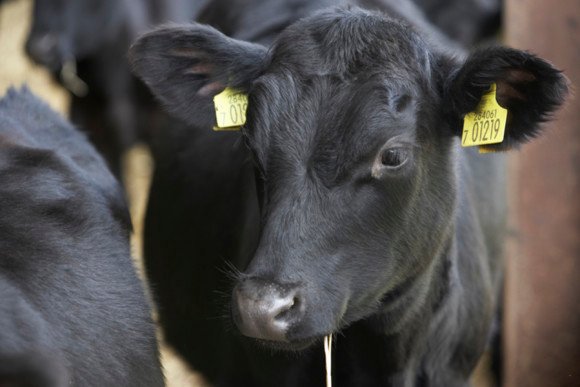
by Joanna | Going Green
I just recently attended the Food Revolution Summit. It was a great event, with great speakers and informative presentations, including Jeffrey Smith who is the leading spokesperson on the dangers of Genetically Modified Organisms (GMOs).
Right now the GMO battle is heating up, big time.
It’s time to educate yourself and start taking action.
Now you can listen to Jeffrey Smith’s Presentation at the Food Revolution Summit on the truth about Genetically Modified Organisms (GMOs). He explains the health and environmental dangers of GMOs, and the politics behind it.
Take Genetically Engineered Foods Out Of Your Diet!
Here you can listen to three Food Revolution Summit interviews on the truth about Genetically Modified Organisms (GMOs).
A majority of Americans say they would choose not to purchase a genetically modified product if given the choice, and yet more than 70% of the foods in US supermarkets and restaurants contain genetically modified ingredients.
FDA scientists warned that GM foods could create unpredictable, hard-to-detect side effects, including allergies, toxins, new diseases, and nutritional problems. Yet despite their recommendations, there have never been any long-term studies conducted on humans.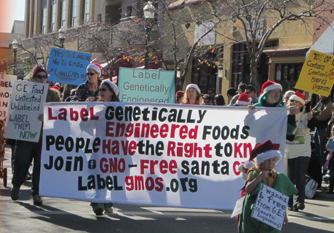
Meanwhile, Monsanto-patented GM seeds are now planted on more than 90% of the US corn, soy, canola and sugar beet cropland. The company is making billions.
Approximately 90% of the American public supports mandatory labeling of genetically modified foods. And yet last week, when two states, Vermont and Connecticut, attempted to pass legislation to require extremely popular GMO labeling, it was legal threats from Monsanto that ultimately killed the legislation.
Knowing full-well that a GM label would have a profound impact on consumer choice and therefore on Monsanto’s profits, the company is threatening to hold states liable for any resultant loss in business.
Some of us, however, think that we should have a right to know what’s in our food. We want the opportunity to make informed choices about whether or not we consume GMOs.
A ballot initiative to require labeling in California, which is the world’s 8th largest economy, would effect packaging and ingredient decisions nationwide and even internationally.
The biotech industry is expected to spend $60 to $100 million trying to defeat the California initiative. They’ll say that it would raise prices, be bad for farmers, and subvert efforts to end world hunger. None of which is true.
But with 80% of Californians currently supporting the labeling initiative, Monsanto and its allies may have a tough time convincing a majority of the state’s voters that they should stay in the dark about what they’re eating.
California’s voters will go to the polls in November for what might be a watershed moment in the struggle. To stay informed, or to contribute time, talent, or treasure to the cause, visit labelgmos.org.
Two of the organizations at the forefront the GMO struggle worldwide are led by Summit speakers Ronnie Cummins (Organic Consumers Association) and Jeffrey Smith (Institute for Responsible Technology).
“The arc of the moral universe is long”, Dr. Martin Luther King, Jr., told us, “but I believe it bends towards justice.”
It doesn’t bend all by itself.



















